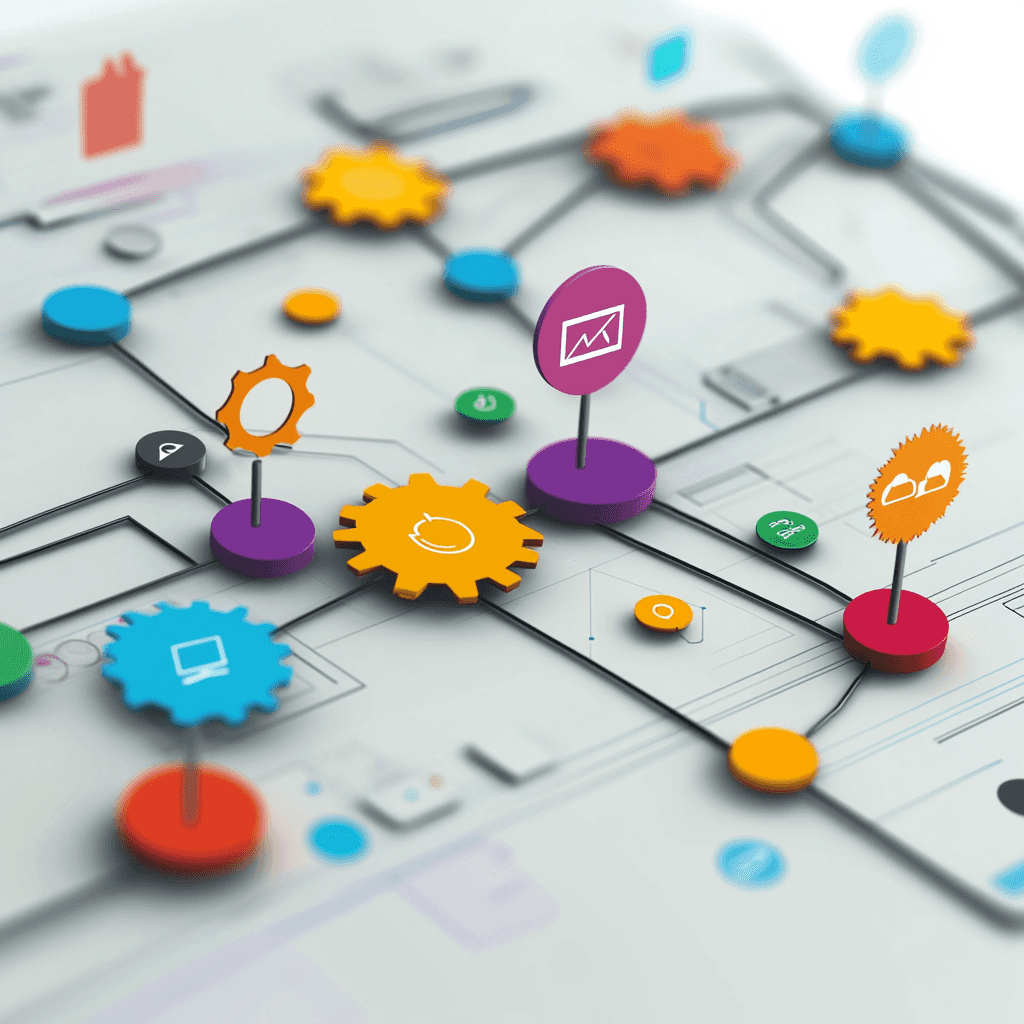In the fast-paced world of mobile app development, businesses constantly seek efficient frameworks that offer speed, flexibility, and cost-effectiveness. Among the various technologies available, Flutter stands out as a revolutionary platform for cross-platform development. Developed by Google, Flutter enables developers to create high-quality applications for both Android and iOS from a single codebase, drastically reducing development time and costs. Let’s explore how Flutter app development is transforming the industry.
The Power of Cross-Platform Development with Flutter
Flutter has revolutionized cross-platform development, offering businesses a powerful tool to create mobile apps for both iOS and Android using a single codebase. Traditionally, companies needed separate teams to build apps for different platforms, resulting in higher costs and longer development times. Flutter changes this by allowing developers to write one codebase that functions across multiple platforms without compromising performance or user experience.
At the heart of Flutter is the Dart programming language, which compiles directly into native code. This means apps built with Flutter offer native-like performance—a critical advantage over other cross-platform frameworks like React Native or Ionic, which often rely on intermediate layers or WebViews that can slow down performance. With Flutter, users experience fast, smooth apps, regardless of their device.
Single Codebase Efficiency
One of Flutter’s biggest strengths is its ability to reduce development time through a single codebase. This eliminates the need for writing separate codes for iOS and Android, significantly cutting down on both development time and maintenance. It also ensures that the app’s design and functionality remain consistent across platforms, giving users a seamless experience no matter which device they use.
Hot Reload for Faster Development
A key feature that developers love about Flutter app development is its Hot Reload functionality. Hot Reload allows developers to see the effects of code changes instantly without restarting the entire app. This boosts productivity by enabling rapid prototyping, debugging, and iteration, making the development process much faster and more flexible.
Native Performance and UI Flexibility
While many cross-platform development frameworks struggle to deliver native-like performance, Flutter excels by compiling into native ARM code, ensuring smooth, high-performance applications. Flutter’s widget-based architecture also enables developers to build highly customizable, platform-specific UIs that adhere to the look and feel of both iOS and Android, enhancing the user experience.
In short, Flutter’s ability to combine the benefits of cross-platform development with near-native performance and a highly customizable UI makes it an ideal choice for businesses looking to launch high-quality apps quickly and cost-effectively.
Key Features That Set Flutter Apart

Flutter has become a popular choice for mobile app developers, largely due to its rich set of features that enhance both the development process and the performance of the final product. These features make Flutter app development a preferred option for creating cross-platform apps with ease and efficiency. Let’s take a closer look at the key features that set Flutter apart from other mobile development frameworks.
Hot Reload for Instant Feedback
One of the standout features of Flutter is Hot Reload, which allows developers to see the results of their code changes in real time without restarting the app. This capability dramatically speeds up the development process, enabling rapid testing, debugging, and tweaking of the UI. Hot Reload enhances productivity by allowing developers to quickly fix bugs or test new features, thus reducing the time to market.
For example, if a developer wants to adjust the layout or appearance of a button, they can simply make the change in the code, and with a quick Hot Reload, the updated button will appear instantly in the app. This not only saves time but also allows for a more creative, experimental approach to app development.
Customizable Widgets
Flutter is built around the concept of widgets, which are essentially reusable elements that developers use to create the app’s user interface. Flutter comes with a comprehensive library of pre-built widgets, which follow the design guidelines of both Material Design (for Android) and Cupertino (for iOS). These widgets are customizable, allowing developers to craft unique and beautiful interfaces that still adhere to the platform’s native style.
The flexibility of widgets is one of the key reasons why Flutter is so popular among developers. Whether it’s simple buttons or complex layouts, Flutter’s widgets can be customized to create highly interactive and visually appealing UIs. Additionally, developers can create custom widgets from scratch, giving them total control over the design and functionality of the app.
Native-Like Performance
Unlike other frameworks that rely on JavaScript bridges or WebViews, Flutter apps are compiled directly into native code, which means they perform just as well as apps developed in native languages like Swift for iOS or Kotlin for Android. This native performance is especially important for apps that require smooth animations, fast interactions, and complex functionalities. Users can enjoy a seamless experience without the lags or performance drops commonly associated with some cross-platform frameworks.
Access to Native Features
Flutter also offers easy access to native device features like GPS, camera, storage, and Bluetooth through its platform channels. This ensures that Flutter apps can take full advantage of the device’s hardware and native functionalities, bridging the gap between cross-platform development and native app development. Developers can easily implement features like fingerprint authentication or push notifications without writing separate code for each platform.
These key features—Hot Reload, customizable widgets, native performance, and seamless access to native features—give Flutter a competitive edge in the mobile app development space, making it an attractive option for developers looking to build efficient, scalable, and high-performing cross-platform apps.
The Advantages of Flutter for Mobile App Development
Flutter offers a wide array of advantages that make it a game-changer for mobile app development. From faster development cycles to enhanced user experiences, Flutter provides a streamlined approach to building high-performance, cross-platform apps. Let’s dive into some of the most significant benefits that Flutter app development brings to businesses and developers alike.
Faster Time to Market
One of the most immediate advantages of Flutter app development is the significant reduction in time to market. By using a single codebase for both Android and iOS, developers no longer have to build separate apps for each platform. This drastically reduces the time spent on writing and testing code for multiple platforms, allowing businesses to launch their apps more quickly.
Additionally, Flutter’s Hot Reload feature, which allows developers to make changes and see the results in real time, further accelerates the development process. Whether it’s fixing bugs or tweaking the UI, Hot Reload minimizes the delays that typically occur during the development cycle. This speed is crucial for companies looking to release updates or new features rapidly, giving them a competitive edge in a fast-paced market.
Cost-Effective Development
Flutter’s ability to use a single codebase for both platforms translates into considerable cost savings. In traditional app development, businesses need to hire separate teams of developers for iOS and Android, each working on platform-specific code. With Flutter, one team can handle both platforms, significantly reducing development costs.
Moreover, ongoing maintenance and updates become much simpler and more affordable. Since the codebase is unified, any changes, updates, or bug fixes can be made across platforms simultaneously. This not only saves time but also reduces the cost of maintaining the app post-launch, making Flutter an ideal solution for companies working with limited budgets or aiming for cost efficiency.
High-Performance Apps with Native-Like Experience
Performance is a critical factor in mobile app development, and Flutter shines in this area. Since Flutter apps are compiled into native code, they deliver near-native performance. This is a significant improvement over hybrid frameworks that rely on JavaScript bridges or WebViews, which can result in slower performance, especially for apps with complex animations or heavy processing needs.
The ability to optimize performance is especially important for apps that need to handle intensive tasks, such as gaming, video streaming, or data processing. Flutter’s architecture ensures that users get a smooth, responsive experience, with fast load times and fluid animations, regardless of the platform.
Consistent UI and UX Across Platforms
Flutter’s widget-based architecture ensures that user interfaces (UIs) remain consistent across platforms. This is a crucial advantage for businesses that want to offer a seamless user experience (UX) across Android and iOS devices. Flutter’s pre-built widgets follow the design guidelines for both platforms—Material Design for Android and Cupertino for iOS—ensuring that the app looks and feels native to each operating system.
At the same time, developers have the freedom to customize these widgets, allowing them to create a unique design while maintaining functionality. This combination of consistency and flexibility is key to delivering a cohesive brand experience to users across different devices, boosting user satisfaction and retention.
Ongoing Support from Google and a Growing Community
Flutter is backed by Google, which means it benefits from regular updates, strong support, and ongoing development. As a result, Flutter is constantly evolving to meet the needs of modern app development. Google’s commitment to the framework ensures that it will continue to improve in terms of performance, functionality, and ease of use.
Additionally, Flutter boasts a large and growing community of developers, which means extensive resources, libraries, and plugins are available to enhance development. This ecosystem of support makes it easy to find solutions, collaborate with other developers, and keep up with the latest trends in Flutter app development. For businesses, this means they can rely on a stable, widely supported technology for their mobile app projects.
Flutter vs. Other Cross-Platform Frameworks

As the demand for cross-platform development continues to grow, businesses and developers have a variety of frameworks to choose from. Among the most popular are Flutter, React Native, Xamarin, and Ionic. While each of these frameworks offers its own strengths, Flutter has emerged as a top contender due to its unique combination of performance, flexibility, and ease of use. Let’s explore how Flutter compares to these other mobile app frameworks in key areas such as performance, user interface, and cost efficiency.
Performance and Native-Like Experience
Flutter excels in terms of performance because it compiles directly into native machine code, resulting in near-native performance. This is especially crucial for apps that require complex functionalities, heavy animations, or real-time interactions. In contrast, frameworks like React Native and Ionic rely on JavaScript bridges or WebViews, which can create performance bottlenecks and lag, particularly in resource-heavy applications. While React Native also delivers good performance, it falls slightly short when compared to Flutter’s ability to handle high-end graphics and animations smoothly.
Xamarin performs well for many use cases as it also compiles into native code, but its larger app sizes and dependency on Microsoft technologies can be limiting for some developers. For simpler apps or those with less complex UIs, Ionic offers decent performance, but it relies heavily on web technologies, making it more suitable for lightweight applications rather than data-intensive mobile apps.
User Interface and Customization
When it comes to creating intuitive and visually appealing UIs, Flutter stands out thanks to its widget-based architecture. Flutter’s comprehensive library of pre-built widgets adheres to the design guidelines of both Material Design (for Android) and Cupertino (for iOS), ensuring that apps look native on both platforms. Moreover, these widgets are fully customizable, giving developers complete control over how the app looks and feels. This flexibility allows businesses to deliver a consistent user experience (UX) across platforms while offering unique customizations to fit brand aesthetics.
React Native, on the other hand, uses native components, which can limit customization options compared to Flutter’s more flexible approach. Xamarin also provides native components for UI development but may require additional work to achieve a uniform look across platforms. Ionic, being a web-based framework, uses WebViews to render the UI, which can result in a less polished, less native look and feel.
Development Speed and Cost Efficiency
One of Flutter’s greatest strengths is its ability to significantly reduce development time. With its single codebase approach, businesses can develop apps for both iOS and Android simultaneously, saving considerable time and effort. Additionally, features like Hot Reload allow for rapid iteration, enabling developers to see changes in real-time and fix bugs instantly without restarting the app.
React Native also allows for code sharing between platforms, but its reliance on third-party libraries and tools can sometimes complicate the development process. Similarly, Xamarin offers code sharing, but its integration with Microsoft’s ecosystem may require more specialized skills and can lead to longer development times. Ionic, while fast for simpler apps, may not perform as well with more complex features, requiring more optimization and thus increasing development time for feature-rich applications.
In terms of cost efficiency, Flutter’s ability to use a single codebase for multiple platforms makes it an ideal choice for companies with limited budgets or those looking to optimize development costs. It reduces the need for large development teams working on separate platforms and simplifies the maintenance process, as updates and bug fixes are applied across both platforms simultaneously.
Community Support and Ecosystem
Flutter has seen rapid growth in its developer community, largely due to Google’s support and continuous investment in the platform. This strong backing ensures that Flutter stays up-to-date with new features, libraries, and tools that make development more efficient. The Flutter ecosystem includes a wide array of third-party packages, extensive documentation, and active developer forums, providing plenty of resources for new and experienced developers alike.
React Native also has a large, mature community and is backed by Facebook, making it a popular choice with plenty of third-party libraries. However, it still requires third-party modules for certain native functionalities, which can complicate development. Xamarin, supported by Microsoft, benefits from strong developer resources but is more niche compared to Flutter and React Native. Ionic, while also having a large community, is less commonly used for high-performance apps, limiting its ecosystem compared to Flutter and React Native.
Comparison Table: Flutter vs. Other Cross-Platform Frameworks
| Programming Language | | |
| UI Framework | | |
| Performance | | |
| Hot Reload | | |
| Development Speed | | |
| Cost Efficiency | | |
| Community Support | | |
| Access to Native APIs | - Direct through Platform Channels
| - Relies on third-party libraries
|
| Best Use Case | - Complex, highly customized apps
| - Apps with simpler UIs and performance needs
|
Why Choose Flutter Over Other Frameworks?

When choosing a mobile app framework, it’s essential to weigh performance, flexibility, and cost-efficiency. Flutter consistently stands out for its native-like performance, extensive UI customization options, and a unified codebase that accelerates development and reduces costs. Its growing community and Google’s ongoing support make it a forward-looking solution for businesses looking to scale their mobile app presence. Whether you’re building an MVP or a complex, high-performance app, Flutter offers the tools and capabilities to deliver on both quality and efficiency.
Why Flutter is the Future of Mobile App Development
As mobile app development continues to evolve, businesses and developers are leaning towards frameworks that offer efficiency, scalability, and high performance. Flutter, with its cross-platform capabilities and innovative features, is at the forefront of this shift. Beyond being just another framework, Flutter app development is paving the way for a more seamless, cost-effective, and future-ready approach to building mobile applications. Here’s why Flutter is quickly becoming the future of mobile app development.
Versatility Across Platforms
Flutter’s most compelling feature is its multi-platform capabilities. While it is often associated with mobile development, Flutter is a versatile framework that extends its reach far beyond just Android and iOS. Flutter allows developers to create applications for the web, desktop (Windows, macOS, Linux), and even embedded devices. This flexibility is essential for businesses that want to provide a consistent experience across all user devices.
Imagine a business needing to build not only a mobile app but also a web app and desktop version. Traditionally, this would require separate development efforts for each platform, often resulting in higher costs and a longer time to market. With Flutter, a single codebase can power all these platforms, ensuring a unified user experience and significantly reducing development time. This makes it particularly attractive for startups looking to launch an MVP across multiple platforms or for enterprises expanding their digital presence into new devices and environments.
Moreover, Flutter’s versatility ensures that as new platforms and devices emerge, developers can easily extend their apps to those platforms without starting from scratch. This future-proofing allows companies to adapt quickly to technological advancements and shifts in user behavior.
Google’s Continuous Investment and Support
One of the reasons Flutter is seen as the future of mobile app development is the continuous investment and support it receives from Google. Google has committed significant resources to developing and improving Flutter, ensuring that it stays ahead of the curve in terms of features, performance, and developer support.
This backing means that Flutter benefits from regular updates, new features, and integration with other Google services like Firebase and Google Cloud. For developers, this means they are working with a framework that is constantly evolving to meet the latest technological demands. For businesses, it provides long-term confidence in the platform, knowing that it will continue to be relevant and well-supported in the years to come.
Additionally, Google has used Flutter internally for some of its own major projects, such as Google Ads and Google Pay, showcasing the framework’s reliability and scalability. The fact that Google trusts Flutter for mission-critical applications is a strong endorsement of its capabilities.
Building for Emerging Technologies
As mobile app development expands into new and emerging technologies, Flutter is well-positioned to meet the demands of the future. Today, businesses are increasingly looking to integrate AI, machine learning, augmented reality (AR), and virtual reality (VR) into their apps to provide enhanced user experiences. Flutter’s flexibility and compatibility with these advanced technologies allow developers to seamlessly incorporate these features into their apps.
For instance, AI-powered features such as predictive analytics, chatbots, and personalized recommendations can be easily integrated into Flutter apps. This enables businesses to deliver smarter, more intuitive experiences to users without having to overhaul their development process. Similarly, AR and VR features can be incorporated to create immersive shopping experiences, gaming environments, or interactive learning tools.
Flutter’s rich plugin ecosystem, including integrations with AI libraries and AR/VR frameworks, makes it an ideal platform for developing apps that leverage emerging technologies. This ability to adapt to the future needs of app development ensures that businesses using Flutter can stay competitive in an increasingly tech-driven market.
Scalability for Businesses
Flutter is not just a solution for small startups or MVPs—it’s a framework that can scale to meet the needs of large enterprises. As businesses grow and their apps become more complex, they need a development platform that can grow with them. Flutter’s architecture allows for easy scalability, making it suitable for businesses of all sizes.
For companies that anticipate needing to scale their apps to handle a large user base or introduce new, complex features, Flutter provides a stable and flexible foundation. Because Flutter uses widgets to build user interfaces, developers can add or modify features without disrupting the overall app architecture. This modular approach to UI design makes it easier to scale apps as needed.
Moreover, Flutter’s single codebase ensures that as businesses expand into new markets or devices, they can maintain a consistent app experience across platforms without having to invest heavily in separate development teams for each platform. This reduces the complexity and cost of scaling digital products, making it an attractive option for businesses with long-term growth ambitions.
Meeting Market Demands for Speed and Efficiency
In today’s highly competitive app market, speed to market is a critical factor in determining success. Flutter is designed to help businesses and developers meet the growing demand for faster, more efficient development cycles. Flutter’s Hot Reload feature, which allows developers to see the results of code changes in real time, accelerates the entire development process. This means developers can quickly prototype, test, and deploy features without the need for long re-compilation times.
For businesses, this speed is invaluable. It allows for rapid iteration, enabling companies to quickly respond to user feedback or market changes. In industries like e-commerce, healthcare, and fintech, where agility is essential, Flutter enables businesses to push updates and new features faster than traditional development approaches.
Additionally, by using a single codebase for both iOS and Android, Flutter drastically reduces the time required to develop apps for multiple platforms. This not only shortens the initial development cycle but also makes it easier to roll out updates and fixes across platforms simultaneously. As a result, businesses can keep their apps up to date with minimal downtime or disruption to users.
Flutter’s ability to deliver cost-efficient, high-performance apps quickly is one of the key reasons it’s becoming the go-to framework for businesses looking to stay competitive in a fast-paced digital world.
Growing Ecosystem and Community Support
Flutter’s popularity is not only driven by its technical capabilities but also by its vibrant and growing community of developers. As more companies adopt Flutter, the ecosystem around it continues to expand, with developers contributing libraries, plugins, and resources to support the framework. This strong community support makes it easier for new developers to get up to speed and for businesses to find talent experienced in Flutter app development.
Additionally, the growing number of third-party integrations available for Flutter means that developers can easily add functionality to their apps without needing to build everything from scratch. Whether it’s integrating payment gateways, analytics tools, or social media platforms, the Flutter ecosystem offers a wide range of plugins to enhance app functionality.
This ever-growing community ensures that businesses using Flutter will have access to the latest innovations, best practices, and technical support, further solidifying Flutter as a forward-looking solution for mobile app development.
Conclusion
Flutter is undeniably shaping the future of mobile app development, offering a robust, flexible, and efficient framework that caters to the needs of modern businesses. With its cross-platform capabilities, native-like performance, and strong backing from Google, Flutter is setting a new standard for how apps are built, deployed, and maintained.
One of the key reasons Flutter is revolutionizing the industry is its single codebase approach, which drastically reduces development time and costs. Businesses no longer need to maintain separate teams for iOS and Android development, as a single Flutter team can build, update, and scale apps for both platforms simultaneously. This is especially crucial in today’s fast-paced digital landscape, where speed to market can make the difference between success and failure. Flutter’s Hot Reload feature further accelerates this process, allowing developers to iterate and refine their apps in real-time, making adjustments on the fly without lengthy recompilations.
Moreover, Flutter stands out from its competitors due to its native performance. Unlike other cross-platform frameworks that rely on web views or JavaScript bridges, Flutter compiles directly into native code, ensuring apps run smoothly and efficiently, even when dealing with complex animations or heavy data processing. This native performance ensures that users enjoy a seamless experience, whether they are on iOS or Android, and this consistency across platforms strengthens brand loyalty and user engagement.
Another aspect that solidifies Flutter’s position in the mobile app development landscape is its ability to create customizable user interfaces. Flutter’s widget-based architecture enables developers to design highly unique, visually appealing UIs that provide a consistent look and feel across devices. This ensures that businesses can maintain brand integrity while delivering a user-friendly experience tailored to each platform. Furthermore, Flutter’s widgets are fully customizable, allowing developers to create interfaces that stand out from the crowd while adhering to platform-specific guidelines like Material Design and Cupertino.
Beyond mobile app development, Flutter’s versatility is truly impressive. It is not limited to just iOS and Android but extends to web, desktop, and embedded devices, making it a comprehensive multi-platform solution. This versatility allows businesses to future-proof their digital strategies, enabling them to expand their reach across multiple devices with a unified user experience. Whether it’s launching a mobile app, a web app, or a desktop version, Flutter allows companies to maintain consistency across all platforms, reducing complexity and ensuring that users enjoy a cohesive experience no matter how they interact with the product.
Furthermore, Flutter’s close integration with emerging technologies like AI, AR, and ML ensures that it is not only relevant today but will continue to be a leading choice for mobile app development in the future. As businesses increasingly adopt AI-powered features like chatbots, predictive analytics, and personalized recommendations, Flutter’s flexible architecture makes it easy to integrate these cutting-edge technologies. This ability to adapt to future technological trends allows companies to stay competitive in a rapidly evolving digital landscape.
One of Flutter’s key advantages is the ongoing support from Google. Google’s investment in Flutter ensures that it will remain at the forefront of mobile app development, with regular updates, new features, and improvements. Businesses that choose Flutter can be confident that they are working with a future-proof technology that will continue to evolve. Google’s trust in Flutter for its own products, like Google Ads and Google Pay, further underscores its reliability and scalability for large-scale, mission-critical applications.
Flutter’s scalability is another reason why it is the future of mobile app development. Whether you’re a startup launching an MVP or a large enterprise with millions of users, Flutter’s architecture can scale to meet the needs of your growing business. Its ability to support complex, feature-rich applications while maintaining high performance and a consistent user experience makes it a solid choice for companies with long-term growth ambitions.
In terms of cost efficiency, Flutter provides unparalleled value. The ability to develop, maintain, and update apps for multiple platforms using a single codebase drastically reduces development costs. Additionally, the time saved by Flutter’s Hot Reload feature and its simplified testing and maintenance processes makes it a cost-effective solution for businesses of all sizes. For startups and small businesses with limited budgets, Flutter offers an affordable way to develop high-quality apps, while enterprises benefit from the long-term savings associated with maintaining a unified codebase.
Finally, Flutter’s growing community and ecosystem are key factors in its continued success. As more developers and businesses adopt Flutter, the ecosystem around it expands, providing an ever-increasing array of libraries, tools, and third-party integrations. This vibrant community ensures that businesses using Flutter have access to the latest innovations, best practices, and technical support, helping them stay ahead in the competitive mobile app landscape.
In summary, Flutter app development offers a comprehensive solution that combines speed, efficiency, and flexibility with high-performance capabilities and a versatile platform reach. Its ability to deliver native-like performance across multiple platforms from a single codebase, combined with Google’s ongoing support and a strong developer community, positions Flutter as the future of mobile app development. Whether you’re looking to create an MVP, scale an existing app, or integrate cutting-edge technologies, Flutter provides the tools and capabilities to achieve your goals in the modern mobile-first world.



















